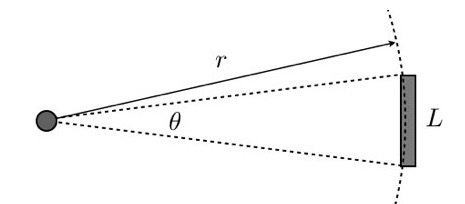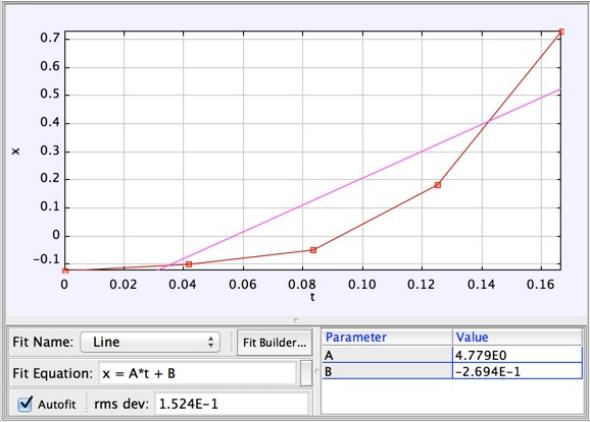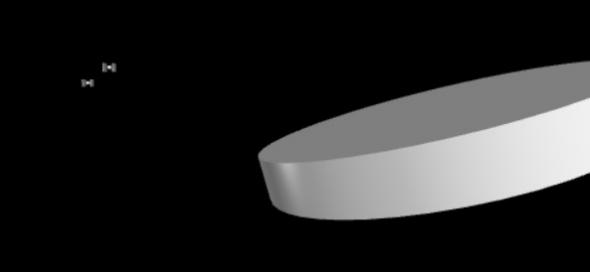How Fast Are the TIE Fighters in Star Wars VII?
Reprinted from 

Screen shot from the Star Wars VII trailer on YouTube.
Will there be TIE Fighters in Star Wars VII? According to the trailer, yes. Now for the real questions: How fast are these TIE Fighters, and how fast are their blaster bolts? Time for some video analysis using Tracker Video Analysis.
Before we get started, I should point out that this video isn’t that easy to analyze. The best videos (the easiest) to analyze have the following features:
- A stationary camera view (non-panning, non-zooming).
- Objects in the frame of a known size.
- Objects moving perpendicular to the direction the camera is facing.
- Objects far enough away from the camera that perspective isn’t a problem.
Based on these features, this is a terrible video. TERRIBLE. On top of that, there are only a few frames for me to look at with the objects moving. Of course, these limitations have never stopped me in the past and they won’t stop me now.
Let me start with just a few assumptions.
Also, there is one physics thing we need to look at. Since the objects are mostly moving towards the “camera,” we can get distance based on the angular size. Basically, the farther away something is the smaller it looks. If you know the actual size and the angular size, you can find the distance to the object. This is the diagram I like to use to describe angular size.

The circle on the left would be a camera. If you know any of the two (angular size, distance, object size) you can find the unknown with the following:

I can measure the apparent size of an object in the video, but that will only give me the angular size if I know the field of view for the camera—which I don’t. I’m going to have to make some guesses in order to use this video. What I would like is to find the distance from the TIE Fighter to the Millennium Falcon. With the distance and time for the blaster bolt, I can get the speed.
Here is what I will do. I will just guess. Let’s say that the Millennium Falcon is 25 meters in front of the “camera.” In this case, I can find the actual angular size and then use this to find the distance to the two TIE Fighters. Here is a plot of the TIE Fighter distances as they fly past the Falcon.
That doesn’t look too bad. The data suggests a constant velocity of the two TIE fighters at about 400 meters per second. Actually, this is the speed relative to the camera. If I assume the Millennium Falcon is moving at about the same speed then the TIE Fighters would be traveling at 200 meters per second (about 450 miles per hour).
But what about the blasters? In the above data, the two TIE Fighters start about 300 meters and 250 meters away from the Falcon (one of the TIE Fighters is farther away). From the video, one of these blaster bolts takes about 0.166 seconds to go from the TIE Fighter to the Falcon. In order to find the distance traveled, I need to subtract the distance the Falcon moved toward the TIE Fighters during this time. If it has a speed of 200 meters per second, that would be just 33 meters. So, let’s say that the blaster moves a distance of 270 meters giving it a speed of 1,626 meters per second. Warning: This data is just an estimate and only to be used for entertainment purposes. Do not use these speeds to develop TIE Fighter evasion strategies.
Is that a fast blaster bolt? Well, you might recall that I have looked at blaster speeds before (if you can’t remember, check it out here). From that analysis, the space-based blasters (except for the Death Star shots) had an estimated speed from between 30 meters per second and 36,500 meters per second with an average of 6,713 meters per second. So this speed seems to fit right in with that data.
Why is there such a large range of blaster speeds in the Star Wars movies? It’s because the blaster bolts are drawn in such a way as to have a nearly constant apparent angular speed. Let me look at the motion of one of these bolts in the Star Wars VII trailer. This is a plot of the apparent angular position of the bolt where the width of the screen is at a distance of 1.
This blaster bolt doesn’t have a constant speed, but it’s average speed is about 4.78 screens/second. This seems quite a bit faster than the 0.5 screens/second from the original Star Wars movies. I don’t know what to say about that.

Concluding Remarks
A few final comments:
- This is a tough video to analyze. Lots of stuff going on. Clearly, someone wanted to set up a situation in which it was all but impossible for me to get any data. Of course I got some data anyway.
- The TIE Fighters and the Millennium Falcon are moving at about 200 meters per second. Interestingly, Wookieepedia lists the maximum atmospheric speed of a TIE Fighter at 1,200 kilometers per hour or 333 meters per second.
- The blaster bolts from the TIE Fighter are moving at about 1,600 meters per second. This is about the speed of a tank round.
- Overall, I think the appearance of these blaster bolts is much better than the bolts in Star Wars Episodes IV-VI. I still need to go back and look at Episodes I-III.
- Blaster bolts still aren’t lasers.
Finally, I would like to add a note to J.J. Abrams.
Dear Sir,
I really enjoyed the trailer for Star Wars VII: The Force Awakens. However, it is clear that it will be difficult to obscure important facts (like the speed of TIE Fighter blasters) from my physics analysis. Might I recommend that you just stop trying to hide things? Instead, you could offer a role in Star Wars VIII (title to be determined). For a small fee, I would gladly accept your offer to be in your film.
Wait, just one more thing. I originally tried to analyze this scene by recreating the objects in Glowscript. It turned out that I didn’t really need it, but here is what it started to look like.

Here is the code if you want to play with it. Yes, I am representing the Falcon as just a disk. You could add some more detail if you like. Actually, it would be fun to animate this so that it does the same thing as the clip from the trailer. That can be your homework if you like.
More from Wired:
Future Tense is a partnership of Slate, New America, and Arizona State University.
